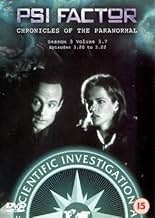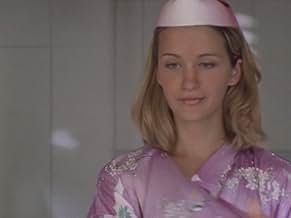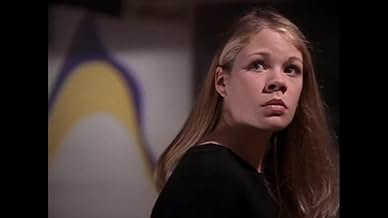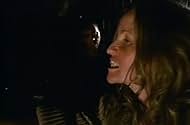Psi Factor, chroniques du paranormal
Original title: PSI Factor: Chronicles of the Paranormal
IMDb RATING
7.1/10
2K
YOUR RATING
A science team that works for the Office of Scientific Investigation and Research (O.S.I.R.) investigates the reports of supernatural phenomena.A science team that works for the Office of Scientific Investigation and Research (O.S.I.R.) investigates the reports of supernatural phenomena.A science team that works for the Office of Scientific Investigation and Research (O.S.I.R.) investigates the reports of supernatural phenomena.
- Awards
- 1 win & 5 nominations total
Browse episodes
Featured reviews
Psi Factor rode a rough road in its 4 years as a series. Conceived as a series based on the purportedly real organization of the OSIR, the stories were supposedly inspired by real life incidents investigated by the organization.
In its first year, the series used a docudrama format, with two 1/2 hour stories a week. They gave the major facts of a case, and the investigators were mostly there to present the story, and not to be active participants. In a lot of ways, while it was interesting, it was not necessary compelling. In two separate episodes, however, they used a single episode format, and the stories presented offered a great more promise than the rest of the episodes that season.
In order to keep the series alive, the producers changed the format for the second season, killing off a major character in the first season finale, and introduced two new character in the first episode of second season. The new characters were Matt Praeger (Matt Frewer) and Michael Kelly (Michael Moriarty)--one, a flippant criminologist with a background in mechanical engineering, and the other, a conspiracy theorist.
Matt Praeger took over the "A" team of the OSIR: the characters who survived the cast culling from first season: Peter Axon (Barclay Hope); Lindsay Donner (Nancy Ann Sakovich); Anton Hendricks (Colin Fox) and a myriad of secondary characters: Claire Davidson (Soo Garay); Lennox Q. Cooper (Peter Blais); Ray Donahue (Peter MacNeill) and Frank Elsinger (Nigel Bennett).
While the series survived through three additional seasons, more changes were instituted, including fourth season characters going missing, the introduction in fourth season of Mia Stone (Joanne Vannicola) and more intimate storylines [with less investigating team members].
The most disturbing change for many fans was the killing off on first season character, Connor Doyle. Many fans were extremely upset at the character's demise, making him very sorely missed for the rest of the show's run. Producers tried to make up for the loss several times, but logistics prevented them from bringing back Paul Miller until near the end of fourth season, where an episode entitled "Regeneration" brought him back to bring some closure to his character's demise.
Overall, the series had some promise, and while it didn't live up to its full potential, there were some promising episodes, and characters that were interesting and full of energy.
In its first year, the series used a docudrama format, with two 1/2 hour stories a week. They gave the major facts of a case, and the investigators were mostly there to present the story, and not to be active participants. In a lot of ways, while it was interesting, it was not necessary compelling. In two separate episodes, however, they used a single episode format, and the stories presented offered a great more promise than the rest of the episodes that season.
In order to keep the series alive, the producers changed the format for the second season, killing off a major character in the first season finale, and introduced two new character in the first episode of second season. The new characters were Matt Praeger (Matt Frewer) and Michael Kelly (Michael Moriarty)--one, a flippant criminologist with a background in mechanical engineering, and the other, a conspiracy theorist.
Matt Praeger took over the "A" team of the OSIR: the characters who survived the cast culling from first season: Peter Axon (Barclay Hope); Lindsay Donner (Nancy Ann Sakovich); Anton Hendricks (Colin Fox) and a myriad of secondary characters: Claire Davidson (Soo Garay); Lennox Q. Cooper (Peter Blais); Ray Donahue (Peter MacNeill) and Frank Elsinger (Nigel Bennett).
While the series survived through three additional seasons, more changes were instituted, including fourth season characters going missing, the introduction in fourth season of Mia Stone (Joanne Vannicola) and more intimate storylines [with less investigating team members].
The most disturbing change for many fans was the killing off on first season character, Connor Doyle. Many fans were extremely upset at the character's demise, making him very sorely missed for the rest of the show's run. Producers tried to make up for the loss several times, but logistics prevented them from bringing back Paul Miller until near the end of fourth season, where an episode entitled "Regeneration" brought him back to bring some closure to his character's demise.
Overall, the series had some promise, and while it didn't live up to its full potential, there were some promising episodes, and characters that were interesting and full of energy.
This is the best 'Sci-Fi' and 'paranormal' T.V series to have hit the screens. It deals with all paranormal activity and explores more themes than the regular X-Files. The special effects are great, so don't miss it.
This one of the most fascinating TV series I have ever seen. I remember watching the series on TV when I was a small child. At that time, the series seemed scary and I actually believed these stories were true.
Now, when I grew up and watched all the series all over again, I could judge those series with more reason. So, I saw a lot of factual errors. Factuals errors occur not in the actual part which thought to be fictional but in ordinary things.
But I have to admit that the screenplays are written in clever and absorbing way, and that helps to keep viewers interested in this project even after the year when it was closed. Not to mention a great bunch of actors who added sincerity to the series. Their professionalism made these series genuine.
All in all, PSI factor will always remain the classical science fiction TV series, which inspired other great project. So its influence is undoubtedly immense.
Now, when I grew up and watched all the series all over again, I could judge those series with more reason. So, I saw a lot of factual errors. Factuals errors occur not in the actual part which thought to be fictional but in ordinary things.
But I have to admit that the screenplays are written in clever and absorbing way, and that helps to keep viewers interested in this project even after the year when it was closed. Not to mention a great bunch of actors who added sincerity to the series. Their professionalism made these series genuine.
All in all, PSI factor will always remain the classical science fiction TV series, which inspired other great project. So its influence is undoubtedly immense.
Since our local station airs Psi-Factor immediately following The X-Files, my acquaintance with this unique Canadian show was inevitable. In the first season, the episodes were split into two separate segments of twenty or so minutes each, and the characters, investigative team members for the O.S.I.R. (Office of Scientific Investigation and Research), did little more than run around muttering techno-babble over their instrumentation. In other words, there wasn't much plot or character development.
By the second season, the format changed to a straight hour with one storyline, which improved things considerably; in my opinion, a show that deals with complex--not to mention, paranormal!--situations such as the ones showcased on Psi-Factor should be at least an hour long! The addition of Matt Frewer to the cast was also a big plus. His familiarity with the sci-fi genre made his settling-in time short and smooth while the character he plays, the off-beat, rebellious Case Manager Matt Praeger, injected some much needed fun and energy into what was a sometimes dour and uptight team. An X-Files-esque conspiracy began to develop as well, hinting at the possibility that perhaps those at the top of the O.S.I.R. echelon weren't simply running a legitimate scientific organization in earnest search of tangible proof of paranormal phenomena, but instead, with sinister governmental and corporate ties, shunt the flow of truth into confidential channels just when Matt and the rest of the team are getting close to something big. Which is where Michael Moriarty enters the picture: as the drunken, chain-smoking conspiracy fanatic with connections, Michael Kelly. He does an excellent job, and adds yet more depth to the show.
Not only do the relatively well-known Frewer and Moriarty shine, Colin Fox as the grandfatherly yet suave Professor Anton Hendricks, Barclay Hope as the protocol-obsessed and rather dishy physicist Peter Axon, Nancy Anne Sakovich as the modelesque, hacking genius, and Soo Garay as a somewhat necrophilic Dr. Claire Davison all give exceptional performances. Secondary characters such as mysterious good guy Case Manager Curtis Rollins (Maurice Dean Wint), dark man at the top Frank Elsinger (Nigel Bennett), and lovable goofball Lennox "L.Q." Cooper (Peter Blais) the team's cryptozoologist, always lend their own unique flavour to each episode they appear in.
With the third season came better effects, even more character development (as well as friction!), and higher quality scripts--which included some more in-depth explorations of the dubious string-pulling up top.
This show has really come a long way! Take a look at an early episode of the X-Files, you're bound to be shocked by the vast difference in quality compared to episodes from the most recent few seasons. I believe we're seeing a similar progression with the fantastic--in every way--Psi-Factor. Way to go Dan Ackroyd and crew!
By the second season, the format changed to a straight hour with one storyline, which improved things considerably; in my opinion, a show that deals with complex--not to mention, paranormal!--situations such as the ones showcased on Psi-Factor should be at least an hour long! The addition of Matt Frewer to the cast was also a big plus. His familiarity with the sci-fi genre made his settling-in time short and smooth while the character he plays, the off-beat, rebellious Case Manager Matt Praeger, injected some much needed fun and energy into what was a sometimes dour and uptight team. An X-Files-esque conspiracy began to develop as well, hinting at the possibility that perhaps those at the top of the O.S.I.R. echelon weren't simply running a legitimate scientific organization in earnest search of tangible proof of paranormal phenomena, but instead, with sinister governmental and corporate ties, shunt the flow of truth into confidential channels just when Matt and the rest of the team are getting close to something big. Which is where Michael Moriarty enters the picture: as the drunken, chain-smoking conspiracy fanatic with connections, Michael Kelly. He does an excellent job, and adds yet more depth to the show.
Not only do the relatively well-known Frewer and Moriarty shine, Colin Fox as the grandfatherly yet suave Professor Anton Hendricks, Barclay Hope as the protocol-obsessed and rather dishy physicist Peter Axon, Nancy Anne Sakovich as the modelesque, hacking genius, and Soo Garay as a somewhat necrophilic Dr. Claire Davison all give exceptional performances. Secondary characters such as mysterious good guy Case Manager Curtis Rollins (Maurice Dean Wint), dark man at the top Frank Elsinger (Nigel Bennett), and lovable goofball Lennox "L.Q." Cooper (Peter Blais) the team's cryptozoologist, always lend their own unique flavour to each episode they appear in.
With the third season came better effects, even more character development (as well as friction!), and higher quality scripts--which included some more in-depth explorations of the dubious string-pulling up top.
This show has really come a long way! Take a look at an early episode of the X-Files, you're bound to be shocked by the vast difference in quality compared to episodes from the most recent few seasons. I believe we're seeing a similar progression with the fantastic--in every way--Psi-Factor. Way to go Dan Ackroyd and crew!
I have never understood why this show never "made it" with the masses as X-Files did. Being a fan of both shows, I always thought Psi-Factor was the better of the two. I even loved the time slot of 11pm CST on Saturday night. My wife and I always looked forward to watching it. It originally started out as one 1-hour episode with two different case files, essentially, a 2-for-1 episode each week. There were a few minor tweaks in storyline and characters throughout its run of four(?) seasons. But overall, a very interesting and rewarding show to say the least. I was disappointed when the show was cancelled, and now I can hardly wait until the DVD Box sets are released.
Did you know
- TriviaDEFINITION: "PSI Factor" - In anomalistics, the unquantifiable unknown aspect of an anomalous (paranormal) phenomenon.
- Quotes
Matt Praeger: Between doing her hair in ponytails and swooning over the Backstreet Boys, it seems my daughter's been dabbling in witchcraft. But apparently it's okay, see, because it's the good kind.
- ConnectionsReferenced in Witchouse 2 (2000)
Details
Contribute to this page
Suggest an edit or add missing content

Top Gap
By what name was Psi Factor, chroniques du paranormal (1996) officially released in India in English?
Answer

































